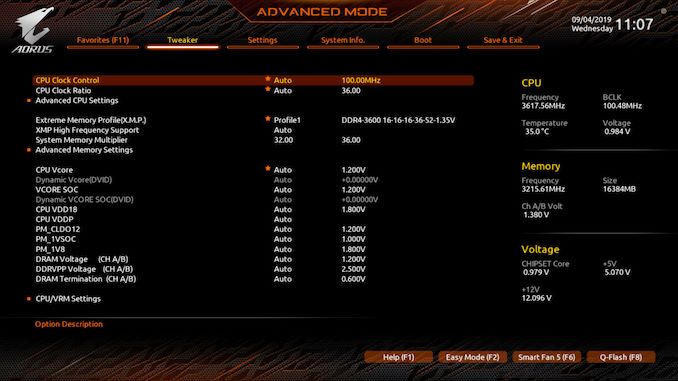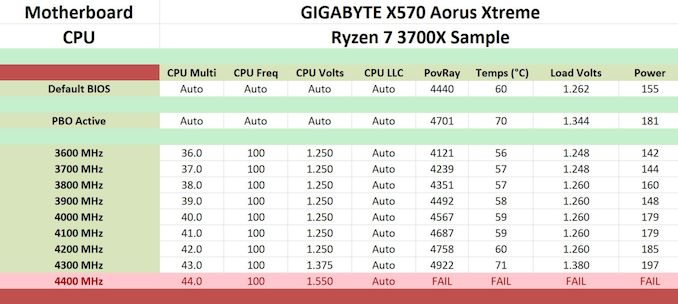The GIGABYTE X570 Aorus Xtreme Motherboard Review: Fanless AM4
by Gavin Bonshor on September 24, 2019 9:00 AM ESTOverclocking Ryzen 3000
Experience with the GIGABYTE X570 Aorus Xtreme
Users looking to get the most from the new Ryzen 3000 series of processors will likely be considering a little overclock. With the current iteration of Precision Boost Overdrive or PBO for short looking a little roughshod at present, the best performance gains can be had from simply overclocking the processor to a reasonable amount. A couple of things to consider first before overclocking your processor. Firstly the cooling is a considerable bulk of the potential overclocking yield as the Ryzen 3000 series tends to run quite warm, even at the default settings on the basic stock cooler. The second main variable is the motherboard that's been selected for the job. With cheaper motherboards which utilize weaker and less efficient power deliveries, with less durable designs. It is prudent to forward think these decisions before purchasing, but it's good to know that all of AMD's X570 all support overclocking from the bottom to the very top.
GIGABYTE's Aorus firmware, for the most part, is very easy to navigate around, with all of the overclocking related settings housed within the Tweaker sub-section of the advanced mode. As the X570 Aorus Xtreme is designed with overclocking in mind due to the impressive 16-phase power delivery, the firmware offers plenty of options for overclocking both CPU and memory. The CPU Core ratio can be adjusted in increments of 0.25 MHz which is useful for fine-tuning, whereas users can also enable memory X.M.P profiles and tweak memory with plenty of primary, secondary, and tertiary memory latencies settings which are found under the advanced memory settings section. Users can also enable Precision Boost Overdrive which is AMD's integrated CPU overclocking technology, but users can also fine-tune certain power variables for a more advanced and customized experience.
As with many vendors including its own pre-defined overclocking profiles, it's a little bizarre that a board of this pedigree has none for users to select from. Perhaps GIGABYTE has made an assumption that users looking to use the X570 Aorus Xtreme as the foundation for their new system might want to create everything themselves, but even a couple of basic profiles with general variables would have been nice to see; not everyone who spends a vast amount of cash is experienced in overclocking and profiles offer a gateway for novice users looking for extra performance from a simple click.
Overclocking Methodology
Our standard overclocking methodology is as follows. We select the automatic overclock options and test for stability with POV-Ray and OCCT to simulate high-end workloads. These stability tests aim to catch any immediate causes for memory or CPU errors.
For manual overclocks, based on the information gathered from the previous testing, starts off at a nominal voltage and CPU multiplier, and the multiplier is increased until the stability tests are failed. The CPU voltage is increased gradually until the stability tests are passed, and the process repeated until the motherboard reduces the multiplier automatically (due to safety protocol) or the CPU temperature reaches a stupidly high level (105ºC+). Our testbed is not in a case, which should push overclocks higher with fresher (cooler) air.
Overclocking Results
The lack of preset overclocking profiles can be forgiven due to the nature of how well the X570 Aorus Xtreme performs in our overclock testing. The overclocking performance of the GIGABYTE X570 Aorus Xtreme boasts very tight VDroop with the biggest variation from the value set for the CPU VCore in the firmware by a slight overcompensation of just 0.05 at our highest overclock of 4.3 GHz. Even at the lower frequencies ranging from 3.6 GHz all cores, to 4.2 GHz, we experienced a slight margin of variance by around 0.002 V to 0.01 V which is very impressive, to say the least.
GIGABYTE's biggest win here is that when Precision Boost Overdrive is in the firmware is set from default to enabled, the performance jump in our Pov-Ray testing yielded a massive improvement over stock settings; the score was increased from 4440 to 4701. While this equates to a performance jump of just under 6%, it's still something which other boards we've tested so far on earlier firmware have been able to achieve. Another interesting focal point is the power draw under load at our maximum settings of 4.3 GHz at 1.375 V on the CPU VCore. In comparison to the MSI MEG X570 Godlike which it competes in both spec and pricing, the X570 Aorus Xtreme managed to do this with 24 W of power draw. This shows the efficiency of the power delivery when extra voltage is put through Infineon's new 16-phase XDPE132G5C Digital PWM controller. Overall performance in Pov-Ray increased by a nice margin at each 100 MHz CPU ratio we tested, and we found no anomalies.












42 Comments
View All Comments
Kurosaki - Tuesday, September 24, 2019 - link
Yes, but where do the M2 ssd's go?! :DKWottrich - Tuesday, September 24, 2019 - link
Two between the PCIe slots (there are screws to open up panels in the metal plate covering the lower part of the board), and one on the back. The one on the back is the one that disables 2 SATA ports if used, as noted in the final page of the article.Aenra - Tuesday, September 24, 2019 - link
Am now wondering if this is the same "reviewer" responsible for the semi-recent Supermicro review.If so, hardly surprised. And regardless.. a 3700X? Seriously? You pick up a behemoth and test it, how? With a 3700X.. well done; again, if it's indeed the same person. Why not a 3400G? I mean it's AM4 and everything, right?
(and if it is the same person, chances are that as with the previous article, i'd find even more glaring issues to name, except this time i can't even bother to read it all; stopped at '3700X')
This site does amazing hard drive reviews; very good CPU reviews; exceptional editorials; but needs some serious love in its mobo review department. It's honestly a shame, stands out compared to the rest.
Respectfully, your average lurker.
shabby - Tuesday, September 24, 2019 - link
What would be the point in testing a 12/16 core? Any x570 board can run one at 4.3ghz+, the board isn't the bottleneck it's the cpu.Death666Angel - Tuesday, September 24, 2019 - link
"semi-recent Supermicro review" If we mean the same thing (C9Z390-PGW), then that review was February 1st. We have very different meanings of "semi-recent" then. And it was also Gavin Bonshor who did that review.imaheadcase - Tuesday, September 24, 2019 - link
If you can't even bother to read the reviewer name in top of article and compare it to another article, and can't read past a single word in this article. What are you even doing here if can't finish simple things.TheinsanegamerN - Tuesday, September 24, 2019 - link
What would you suggest then smart guy? A 3800x that hits the same clock rates +/- 25 MHz? A 3900x that nobody can get ahold of and will hit the SAME clock ceiling?Go back to lurking.
SSTANIC - Tuesday, September 24, 2019 - link
They have been testing it with a 3950X, but its launch and NDA (Sep 30th) have been postponed to November..Smell This - Tuesday, September 24, 2019 - link
"As it currently stands, the GIGABYTE X570 Aorus Xtreme includes the best power delivery of any X570 motherboard we have seen so far in our testing."_____________________________________________________________
Uhhh .... yeah. It thumped the competition, hands down. Nice job, GB.
DanNeely - Tuesday, September 24, 2019 - link
Unless they're including a right angle adapter I think the side pointed 24-pin ATX connector is risky idea. If you're running the cable on the same side of the mobo-tray as the board it's not an issue, but most high end cases today route the cables behind the board with holes just outside. 24 pin cables are really stiff if the wires are bundled together; I had a board with a 90 power plug a about a decade ago (was either LGA1366 or S939) of years ago and the all in a single bundle cable from the PSU wouldn't make the bend; I ended up having to run a big loop into the drive bay area and ended up with more of the cable sticking out than for a conventional top down plugin. Even with that the cable was still very difficult to bend into place to insert and was putting a lot of tension onto the board trying to lift it up from the tray afterward. Individually sleeved wire designs might be OK if you've got a long length from the plug to the last point they're zip-tied together, but a standard fat bundle is asking for trouble.